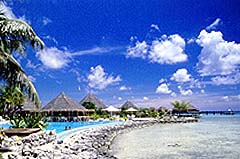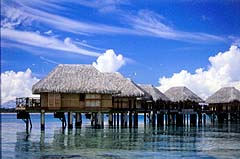Manihi, Taumuto Archipelago
 Manihi offers three types of dives: the lagoon, the reefs that ring the island and the lagoon mouth drift dive. Each of these affords a different type of experience. The lagoons are home to sponges, oysters and shells such as lamis, terebra and mitra. Fish include damselfish, chromis, surgeonfish, groupers, butterflyfish and soldierfish. Also parrotfish, bluejacks, long-nosed emperors, rays and sharks.
Manihi offers three types of dives: the lagoon, the reefs that ring the island and the lagoon mouth drift dive. Each of these affords a different type of experience. The lagoons are home to sponges, oysters and shells such as lamis, terebra and mitra. Fish include damselfish, chromis, surgeonfish, groupers, butterflyfish and soldierfish. Also parrotfish, bluejacks, long-nosed emperors, rays and sharks.
The coral reefs that surround the island are rich in marine life. They harbor many colorful fish and crustaceans and are home to schools of sea perch, snappers, unicornfish and several species of jackfish. The deep waters are rich in tuna, Napoleon wrasse and the long-nosed unicornfish.
The pass which links the lagoon to the ocean is without doubt the richest area. Just outside the mouth of Tairapa Pass, along the gentle sloping reefs, are schools of fish too numerous to count. Due to the generally stronger currents, the underwater scenery and visibility is less impressive but is more than made up by the varieties and numbers of inhabitants. Manta rays favor these waters as they are rich in nutrients. The pass is also the favorite hunting grounds for sharks and barracudas.
There are more sharks in the Tuamotu than in the Society Archipelago. White-tipped, black-tipped and grey reef sharks are seen on every dive sometimes in great numbers. It is common to view schools of 25 or more 3-4 foot white-tipped sharks, their swirling masses when viewed from a distance resemble other types of schooling fish.

July is the time when the maramu (marble grouper) return to the Taumuto Archipelago to repeat an annual ritual enacted over millions of years. Marble groupers numbering in the thousands leave their normal habitats to congregate for the mating ritual. Groupers stay in the pass for eight days then move outside for a couple more. Although fish gatherings are seen throughout Polynesia, Manihi is particular impressive because the pass is so small and of the punctual nature of the event.

Manihi Blue Nui offers some of the best diving in the world. Gilles Petre and the other divemasters know the spots, whether it is incredible schools of Snapper, Grouper, Manta rays, or sharks you seek. A favorite spot for sharks is 'The Break' (pronounced 'Le Brick' by Terray our French divemaster). The site is named for the massive cut in the reef revealing the soft talc-like reef foundation. Huge blocks plummet to the depths creating massive avalanches of carbonate clouds.
The Break is really known for its abundance of reef sharks. As the boat approaches, the blacktip, whitetip and grey sharks assemble below. Before our back-roll entry we must check for floating divers and sharks. It is common for divers to roll on top of a curious shark--startling both!!

The place to stay while diving in Manihi is the Pearl Beach Lodge. All of the beach and overwater bungalows are designed for maximum enjoyment and walking ease to both the restaurant and dive shop. There is even black pearl shopping to fill the time between dives and meals.
The four-star Manihi Pearl Beach Resort offers an enchanting location in the natural, undiscovered beauty of the Tuamotu archipelago. The 22 beach bungalows situated along the palm fringed beachfront give direct access to the lagoon. All bungalows are equipped with telephones, hair dryers, mini-bars, fans, in-room safe and coffee/tea facilities. All the traditional water sports such as canoes, fishing and snorkeling are offered in addition to world-class scuba diving.
Polynesia is known for its richness of marine species and numbers of fish--Manihi ranks among the top in total numbers. Being engulfed by a blizzard of prymaid butterflyfish is a common occurrence while diving the crystal-clear waters of Manihi. Divers remark that more fish can be seen on a single dive than entire dive trips in other areas of the Pacific.
